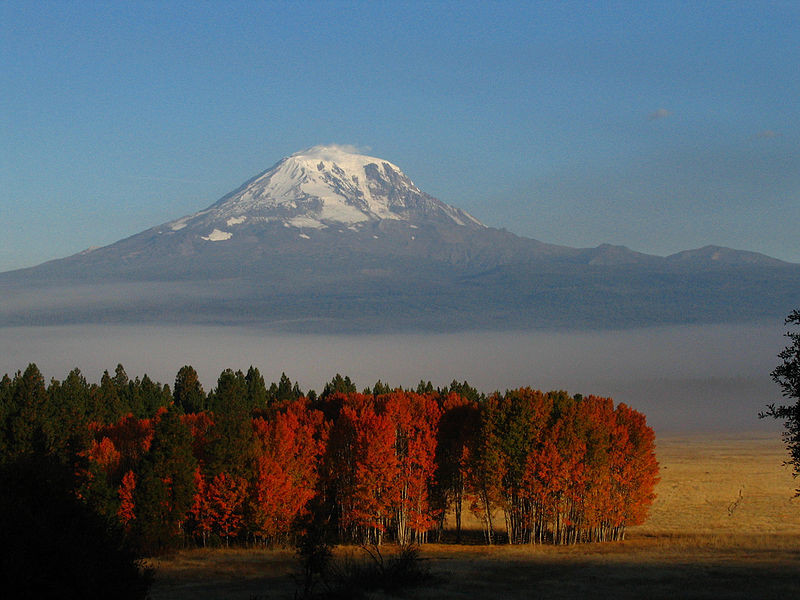
Photo courtesy of US Fish and Wildlife Service
By Jim Drake. Nov. 14, 2019. Home to nesting Sandhill Cranes, roaming elk herds, and the threatened Oregon Spotted Frog, Conboy Lake National Wildlife Refuge is a rich pocket of biodiversity on the east side of the Cascades. The 7,000 acre complex is a mosaic of marsh wetlands, prairie grasslands and mixed conifer forests, and it provides habitat for a number of other rare species, including the Western Grey Squirrel and the delicate Mardon Skipper butterfly.
“We have both Western and Mountain Bluebirds, Flickers, Redwing Blackbirds, woodpeckers, Wilson’s Warbler and eagles,” says Trevor Sheffels, listing off some of the refuge’s feathered residents.
But the birds only represent one piece of the biotic pie. There are hundreds of other species living here, many of which go unnoticed by all but the most curious observers.
“Because the Bitterbrush shrub around here attracts moths, we’re working with a researcher right now. He’s already documented 300 different species, which is mind blowing to me,” Sheffels says.
Now in his third year as Assistant Refuge Manager, Sheffels works for the US Fish and Wildlife Service as the primary caretaker of the refuge, which is situated southeast of Mt. Adams in Glenwood, Wash. Armed with a Ph.D in Environmental Science and Resources, Sheffels and his barebones crew — one maintenance worker and a (currently unfilled) staff technician — are the public stewards of this unique ecosystem, and they manage its wetlands, grasslands, forests and interconnected habitats in a way that benefits this diverse community of native species.
Importance of Wetlands
An important ecological feature at Conboy is the “Camas Prairie” wetlands. Sheffels says this unique habitat is essential to maintaining the biodiversity at Conboy because its associated system of creeks and irrigation ditches create habitat for two of the refuge’s iconic species: the Oregon spotted frog and the Greater Sandhill crane.
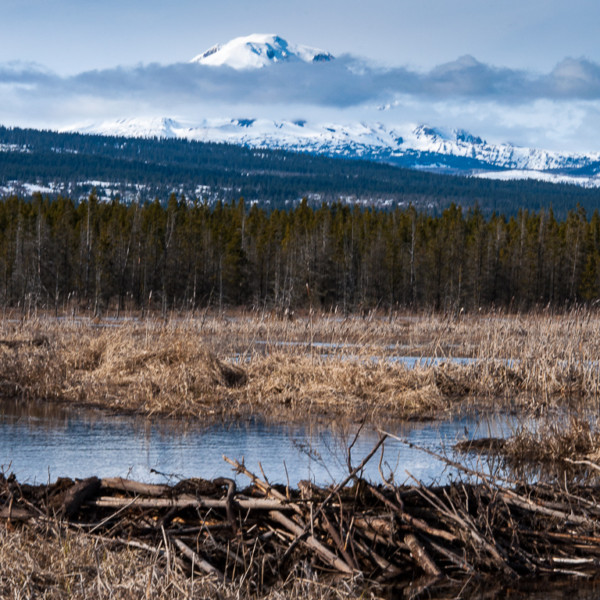
The Camas Prairie wetlands provide year-round habitat for birds, amphibians, beavers and other native species. Photo by Jurgen Hess
“The Oregon spotted frog is an unusual species. It’s highly aquatic and the frog really doesn’t go on land at all.”
“I think we had 30 or 40 volunteers this year helping with the egg mass surveys,” Sheffels continues. He says that over the last 22 years, volunteers have put in thousands of hours of work to ensure the species’ survival.
“We assume that one egg mass represents one mature female, and we use these egg mass counts as an index for population trends over time. Between 2009-2018, the count ranged between 733-1,665 egg masses,” he says.
The results of these egg mass studies show that egg counts are typically higher in units where water levels are controlled by the irrigation system, and this lets Sheffels know that the restoration efforts are paying off.
But there are other factors affecting the spotted frog populations, he says, including another, more aggressive (and invasive) species of frog.
[perfectpullquote align=”full” bordertop=”false” cite=”” link=”” color=”” class=”” size=””]“We know that bullfrogs are eating spotted frogs. This year and starting next year, we have a big project to try to eradicate bullfrogs from the valley.”[/perfectpullquote]
Another way to gauge the overall health of Conboy’s wetland habitat is to look at the Greater Sandhill Crane population, which has slowly made a comeback since 1972.
“We have about 40 pairs of cranes. Although the number of successful nesting birds is unknown, we know it’s been climbing steadily, successfully, for many years now,” Sheffels says.
With a lifespan of 40 years, he says the cranes don’t have to be successful in breeding every single year. And even with a low success rate, the refuge is seeing an increase in their population.
“There’s usually two eggs that are laid, and the breeding pair can rear two colts. But, most of the time, just one will survive,” he explains.

One of the oldest living bird species on the planet, sandhill cranes are an iconic part of the refuge. Photo courtesy of Creative Commons
The frogs and cranes, along with ducks like Cinnamon Teal, mallards and other marsh birds, benefit from the refuge’s system of spring-fed irrigation and drainage ditches that eventually feed the marsh wetlands. Sheffels and his crew manage the flow of this water with diversion structures called stop log risers.
“Historically, spring water water would have come out and slowly filled this wet prairie. With the log risers, we push water different ways by inserting these wooden boards. It’s not a natural way, but we do our best to make it a natural hydrology for different parts of the year,” Sheffels says.
As for natural solutions, he points to Conboy’s engineers in residence: beavers.
“Three years ago, beavers came back and re-built one of their dams. As a result, our frog numbers are coming back up, which is excellent.The beavers are natural engineers and that’s what they do,” Sheffels says.
Grasslands and Grazers
On the north end of the refuge, visitors walking the self-guided foot trail will find a wooden viewing platform. And depending on the time of year, this platform offers a great vantage point for spotting elk herds roaming in the distance.
“The month of May is the time of year when we have the most elk in the valley,” Sheffels says. “Last year I did a driving survey and I was seeing numbers in the 500-600 range, which is pretty good for a valley this size.”
He explains that the elk utilize forests as well as large open areas, and with 2,000 acres of intact forest and 3,500 acres of wet prairie available, the refuge provides enough habitat to support herds over multiple seasons.
“The forests provide movement corridors and cover from disturbance and predators, particularly during the calving season in the spring when young are born. The wet prairie provides open areas with ample vegetation that are attractive for feeding in the summer months,” he says.
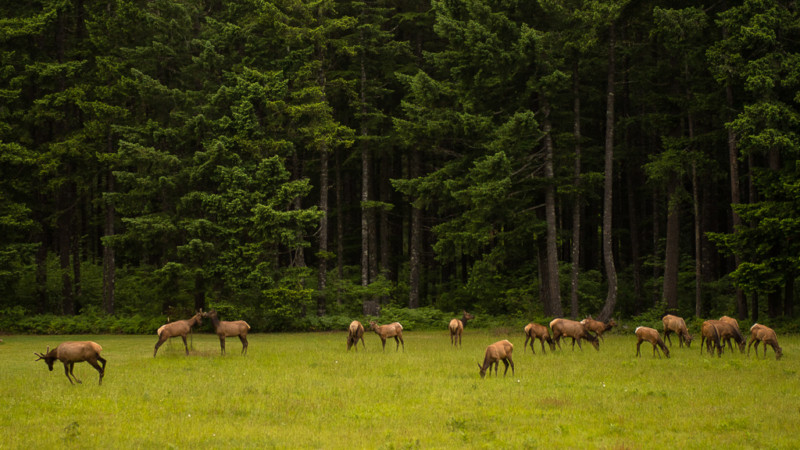
Open prairies adjacent to forested areas provide both forage and shelter for elk herds on the refuge. Photo by Jurgen Hess
“Unfortunately, now we’re dealing with an elk hoof disease, which is a brand new player for us,” Sheffels adds.
“Elk hoof disease was first observed to be affecting a small number of elk at Conboy and the surrounding Glenwood Valley in 2018, and we’re still trying to determine the best course of action. It’s still early in the process with a lot of unknowns.”
The Washington Department of Fish and Wildlife has pointed to treponeme bacteria — found in cows, sheep and other livestock — as a likely cause of the disease. But aside from this potential cause-and-effect relationship, which is debatable and still inconclusive, local cattle operations surrounding Conboy present their own unique set of challenges.
“We do a lot of work with ranchers to try and keep cows out of the sensitive spots of the refuge. Luckily, we have the Youth Conservation Corp come in and keep those fences fixed,” Sheffels says.
[perfectpullquote align=”full” bordertop=”false” cite=”” link=”” color=”” class=”” size=””]“The primary reason for preventing cattle trespass on the refuge is to preserve sensitive habitats. Cattle tend to congregate in seasonal wetlands and stream corridors which can easily become highly compacted and eroded.”[/perfectpullquote]
In some cases, however, cows can actually help by grazing on non-native grasses such as reed canarygrass.
“All refuges have a Comprehensive Conservation Plan. In 2014, grazing was one of the things we evaluated, and it was approved, so it’s a tool we can use. For example, there’s a couple of small units where it’s not realistic to hay, because of a lot of woody debris. Now, we can evaluate grazing as a way to address the vegetation in those units,” Sheffels says.
Managing Forests
Sheffels explains that maintaining habitat for native species means managing the mixed conifer forests on the refuge, and that “we do a lot of work trying to keep the forest from encroaching on the wetlands.”
“We adopted a detailed forest management plan in 2009 to achieve habitat goals using a variety of tools, including thinning and prescribed burning. We are fortunate to have an excellent local non-profit partner, Mt. Adams Resource Stewards, to implement the thinning treatments for each forest stand on the refuge,” Sheffels points out. And he says these thinning methods are far from uniform.
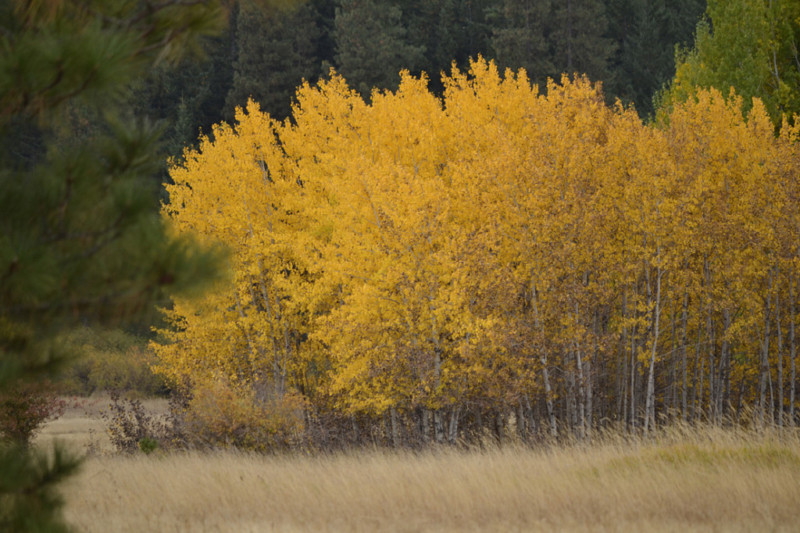
One of the more photogenic trees at the refuge, Conboy’s aspen groves put on a show in the fall. Photo by Jurgen Hess
“In some thick areas we’ll do nothing, some areas we thin to a certain density, or a couple of different densities. We will enhance open areas to make them bigger, so we shoot for a mosaic, like you’d see historically, instead of using one thinning effort that looks the same everywhere.”
Conboy’s current thinning and burning efforts are geared toward getting back to a historical tree density that favors fewer, yet larger, Ponderosa Pines.
“That’s the direction we want to head, instead of having too many trees all close together. It’s gonna take a long time to get there,” Sheffels says.
Another important forest management technique is prescribed burning (or controlled burning), and it is often implemented to restore forested areas, reduce hazardous fuel build up and for forest research studies.
In May of this year, a twenty-person fire crew led by Frank Conner, a Prescribed Fire Specialist for the US Fish and Wildlife Service, conducted a prescribed fire burn on a 600-acre tract of forest land called the Headquarters Unit — which is near Conboy’s ranger station and visitor’s center. Unique to the refuge, the unit is dominated by Ponderosa pine.
“Since 2016 we have been burning 30-300 acres each year on the Headquarters Unit, and this is the forest type most adapted to frequent low intensity fires,” Sheffels says. He explains that a big part of his job is determining what each unit needs to stay healthy ecologically, and using fire to get those results.
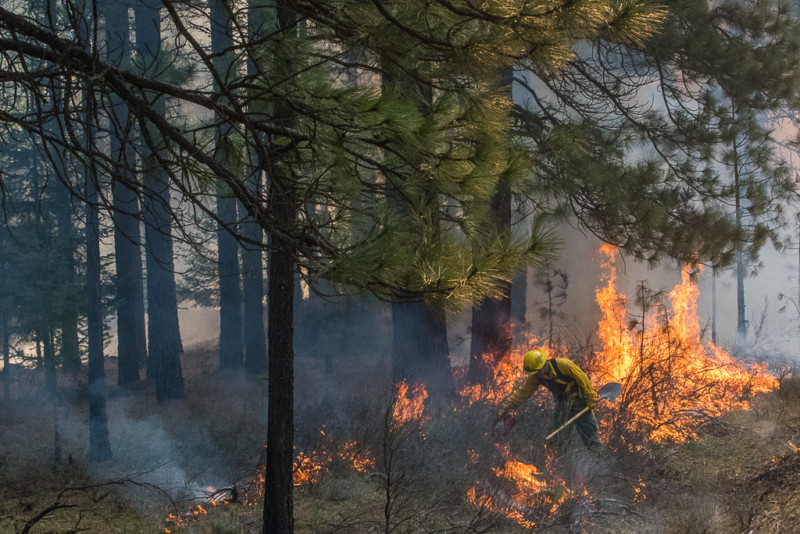
Photo by Jurgen Hess
“Other refuge forest types, including ponderosa and lodgepole pine, mixed conifer (Douglas fir, Ponderosa Pine, Grand Fir), and Aspen are less adapted to frequent low intensity fires, so using prescribed fire as a management tool will be more limited.”
Years of fire suppression at the refuge has allowed too much fuel to build up, he says, and so there is a lot of prep work (in terms of thinning) that must occur before a prescribed burn takes place.
“It’s really for the benefit of the forests and the wildlife here — that’s the whole reason we’re doing these burns,” Sheffels says, speaking to the ultimate goal behind all of the habitat restoration and management work that goes on at Conboy.
Whether it’s prescribed burning, managing cattle or re-engineering wetlands, he says that the WDFW’s mission of wildlife conservation depends on preserving and maintaining the health and viability of these diverse habitats.
“I work for the Fish and Wildlife Service specifically because it was the mission that most resonated with I wanted to do with my career,” Sheffels says. “It’s close to my heart and we appreciate all the support we can get.”



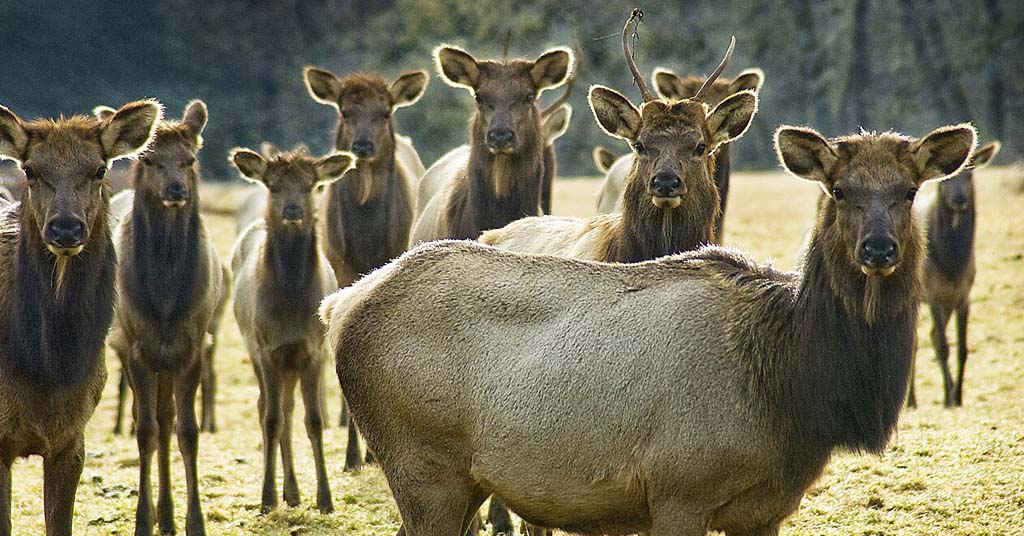
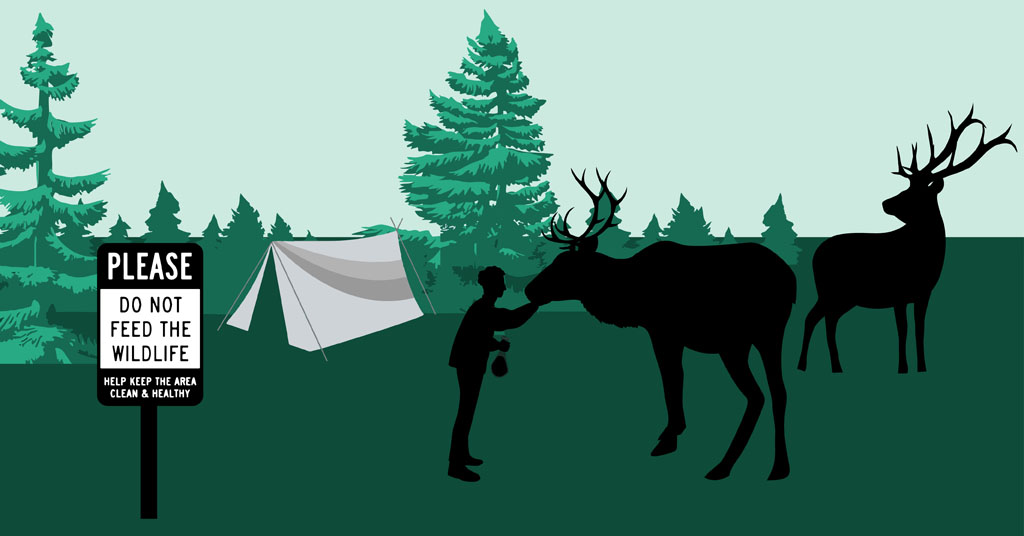
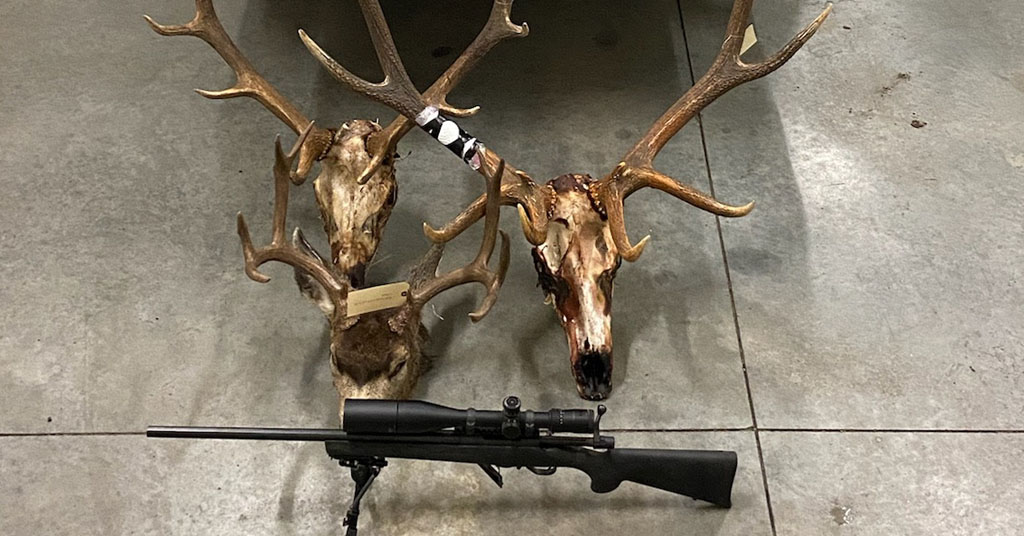




Have you heard of a species of cedar that was once here and clear up into the glenwood area but was cut down for constructing barges/boats for the river to go up to the Idaho gold rush? Evidently cedar stumps of some kind have been found up in that area. I am curious about what species of cedar was it?
Judy, we asked Darryl Lloyd your question. Here’s his reply:
“Of course! As 10-year-olds, we remember the giant Western redcedars that were abundant above where we grew up. We never knew that they were sacrificed for the Idaho gold rush. How very sad! “
Thanks Jim Drake for such an excellent article. Makes me want to get up there more often to observe.
j enlson
This is a fact filled article with great photos, thank you! I walked the north end trail once back in 2016 on a hot summer day. The plant list a group of us checked off was more than 80 native plants, including some very tall Bog Lilies in an irrigation ditch we couldn’t identify. This is a precious resource for a diverse number of native plant communities that would support 500 moth species and probably 100’s of other insect species, including important pollinators for the nearby farmers. Keep up the good work. Is there a “Friends of Conboy Lake” yet to support volunteer efforts?
Willow Elliott for Native Plant Society of OR
Willow, Conboy is part of the Mid-Columbia River National Wildlife Refuge Complex. Their webpage has a lot of information http://friendsofmcrwr.org/.